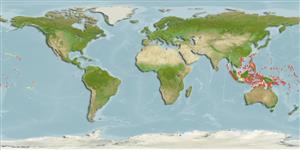Environment: milieu / climate zone / depth range / distribution range
Ecologie
marien rifbewoner; standvastig; diepte 0 - 30 m (Ref. 13227). Tropical; 30°N - 15°S
Western Pacific: Japan (Ref. 76833), Ryukyu Islands to eastern Australia, including Mariana, Marshall, Samoan, and Phoenix islands (Kiribati), the Ouvéa Atoll in the Loyalty Islands, to American Samoa.
Grootte / Gewicht / Leeftijd
Maturity: Lm ? range ? - ? cm
Max length : 4.8 cm SL mannelijk / geslacht onbekend; (Ref. 54980)
Dorsale stekels (totaal): 15 - 16; Dorsale zachte stralen (totaal): 9-10; Anale stekels 1; Anale zachte stralen: 17 - 19. Males have dark lower head and are abruptly dark posterior, occasionally with alternating broad dark and light bands (Ref. 37816 ). Adults are identified by the greenish tail and the color usually extends well onto the body (Ref. 48636). Mature males with two broad, black bands below third dorsal fin base and caudal peduncle, two bands joined ventrally; posterior half of anal fin black in mature males; caudal fin base white; pectoral and pelvic fins and body orange in mature males (Ref. 76833).
Adults are found in various reef habitats (Ref. 48636) especially in reef flats and tidepools (Ref. 90102) and in surf-swept reef margins. Also found in intertidal areas and is usually associated with coralline rock and coral reef lagoons (Ref. 13227). Eggs are hemispherical and covered with numerous sticky threads that anchor them in the algae on the nesting sites (Ref. 240). Larvae are planktonic which occur primarily in shallow, nearshore waters (Ref. 94114).
Levenscyclus en paargedrag
Maturiteit | Voortplanting | Paaien | Eieren | Fecunditeit | Larven
Fricke, R., 1994. Tripterygiid fishes of Australia, New Zealand and the southwest Pacific Ocean (Teleostei). Theses Zool. 24:1-585. (Ref. 13227)
Status op de Rode Lijst van het IUCN (Ref. 130435)
Gevaar voor de mens
Harmless
Gebruik door de mens
Visserij: van geen belang
Meer informatie
Lokale namenSynoniemenMetabolismePredatorenEcotoxicologieVoortplantingMaturiteitPaaienPaaiaggregatiesFecunditeitEierenOntwikkeling van de eieren
ReferentiesAquacultuurAquacultuurprofielKweeklijnenGeneticaElectrophoresesErfelijkheidZiektesVerwerkingNutrientsMassaconversie
Tools
Speciale rapporten
Download XML
Internetbronnen
Estimates based on models
Preferred temperature (Ref.
123201): 27.1 - 29.3, mean 28.7 °C (based on 1529 cells).
Fylogenetische diversiteitsindex (Ref.
82804): PD
50 = 0.5000 [Uniqueness, from 0.5 = low to 2.0 = high].
Bayesian length-weight: a=0.00562 (0.00258 - 0.01228), b=3.08 (2.89 - 3.27), in cm total length, based on LWR estimates for this (Sub)family-body shape (Ref.
93245).
Trofisch niveau (Ref.
69278): 3.2 ±0.3 se; based on size and trophs of closest relatives
Weerstandsvermogen (Ref.
120179): Hoog, minimale populatieverdubbelingstijd minder dan 15 maanden (Preliminary K or Fecundity.).
Fishing Vulnerability (Ref.
59153): Low vulnerability (10 of 100).
Nutrients (Ref.
124155): Calcium = 325 [145, 881] mg/100g; Iron = 1.68 [0.74, 3.29] mg/100g; Protein = 18.2 [16.8, 19.6] %; Omega3 = 0.106 [0.039, 0.307] g/100g; Selenium = 50.5 [14.1, 154.8] μg/100g; VitaminA = 61.8 [13.2, 287.7] μg/100g; Zinc = 3.85 [2.04, 6.37] mg/100g (wet weight);
